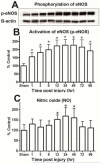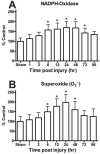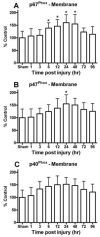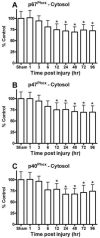A time course of NADPH-oxidase up-regulation and endothelial nitric oxide synthase activation in the hippocampus following neurotrauma
- PMID: 25224032
- PMCID: PMC4313124
- DOI: 10.1016/j.freeradbiomed.2014.08.025
A time course of NADPH-oxidase up-regulation and endothelial nitric oxide synthase activation in the hippocampus following neurotrauma
Abstract
Nicotinamide adenine dinucleotide phosphate oxidase (NADPH-oxidase; NOX) is a complex enzyme responsible for increased levels of reactive oxygen species (ROS), superoxide (O2(•-)). NOX-derived O2(•-) is a key player in oxidative stress and inflammation-mediated multiple secondary injury cascades (SIC) following traumatic brain injury (TBI). The O2(•-) reacts with nitric oxide (NO), produces various reactive nitrogen species (RNS), and contributes to apoptotic cell death. Following a unilateral cortical contusion, young adult rats were killed at various times postinjury (1, 3, 6, 12, 24, 48, 72, and 96 h). Fresh tissue from the hippocampus was analyzed for NOX activity, and level of O2(•-). In addition we evaluated the translocation of cytosolic NOX proteins (p67(Phox), p47(Phox), and p40(Phox)) to the membrane, along with total NO and the activation (phosphorylation) of endothelial nitric oxide synthase (p-eNOS). Results show that both enzymes and levels of O2(•-) and NO have time-dependent injury effects in the hippocampus. Translocation of cytosolic NOX proteins into membrane, NOX activity, and O2(•-) were also increased in a time-dependent fashion. Both NOX activity and O2(•-) were increased at 6 h. Levels of p-eNOS increased within 1h, with significant elevation of NO at 12h post-TBI. Levels of NO failed to show a significant association with p-eNOS, but did associate with O2(•-). NOX up-regulation strongly associated with both the levels of O2(•-) and the total NO. The initial 12 h post-TBI are very important as a possible window of opportunity to interrupt SIC. It may be important to selectively target the translocation of cytosolic subunits for the modulation of NOX function.
Keywords: Free radicals; NADPH-oxidase; Secondary injury cascades; Traumatic brain injury.
Copyright © 2014 Elsevier Inc. All rights reserved.
Figures







References
-
- Langlois JA, Marr A, Mitchko J, Johnson RL. Tracking the silent epidemic and educating the public: CDC's traumatic brain injury-associated activities under the TBI Act of 1996 and the Children's Health Act of 2000. J Head Trauma Rehabil. 2005;20:196–204. - PubMed
-
- Bayir H, Kagan VE, Clark RS, Janesko-Feldman K, Rafikov R, Huang Z, Zhang X, Vagni V, Billiar TR, Kochanek PM. Neuronal NOS-mediated nitration and inactivation of manganese superoxide dismutase in brain after experimental and human brain injury. J Neurochem. 2007;101:168–181. - PubMed
-
- Hall ED, Detloff MR, Johnson K, Kupina NC. Peroxynitrite-mediated protein nitration and lipid peroxidation in a mouse model of traumatic brain injury. J Neurotrauma. 2004;21:9–20. - PubMed
-
- Siesjo BK. Calcium-mediated processes in neuronal degeneration. Ann N Y Acad Sci. 1994;747:140–161. - PubMed
Publication types
MeSH terms
Substances
Grants and funding
LinkOut - more resources
Full Text Sources
Other Literature Sources

